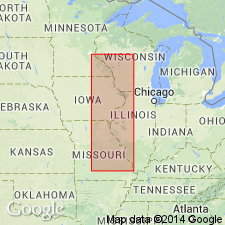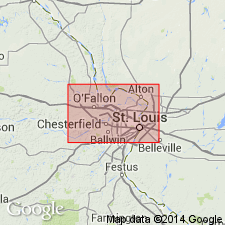
- Usage in publication:
-
- House Springs K-Bentonite Bed
- Modifications:
-
- Named
- Dominant lithology:
-
- Bentonite
- AAPG geologic province:
-
- Ozark uplift
Summary:
House Springs K-Bentonite Bed of Dunleith Formation of Kimmswick subgroup [informal] of Galena Group. Composed of bentonite. Thickness is 1 to 3 cm. Commonly overlain by about 15 cm of argillaceous limestone. Age is Middle Ordovician (Champlainian, Kirkfieldian). Report includes cross sections, stratigraphic sections.
Named for town of House Springs, Jefferson Co., eastern MO.
["Subgroup" not recognized as a formal stratigraphic rank term (CSN, 1933; ACSN, 1961, 1970; NACSN, 1983, 2005, 2021). Considered informal and should not be capitalized.]
Source: Modified from GNU records (USGS DDS-6; Reston GNULEX).

- Usage in publication:
-
- House Springs Bentonite Bed*
- Modifications:
-
- Revised
- AAPG geologic province:
-
- Ozark uplift
Summary:
Revised as House Springs Bentonite Bed of Kimmswick Limestone, but follows definition of Kolata and others (1986). Located about 3 ft (1 m) above base of Kimmswick.
Source: GNU records (USGS DDS-6; Reston GNULEX).
For more information, please contact Nancy Stamm, Geologic Names Committee Secretary.
Asterisk (*) indicates published by U.S. Geological Survey authors.
"No current usage" (†) implies that a name has been abandoned or has fallen into disuse. Former usage and, if known, replacement name given in parentheses ( ).
Slash (/) indicates name conflicts with nomenclatural guidelines (CSN, 1933; ACSN, 1961, 1970; NACSN, 1983, 2005, 2021). May be explained within brackets ([ ]).

